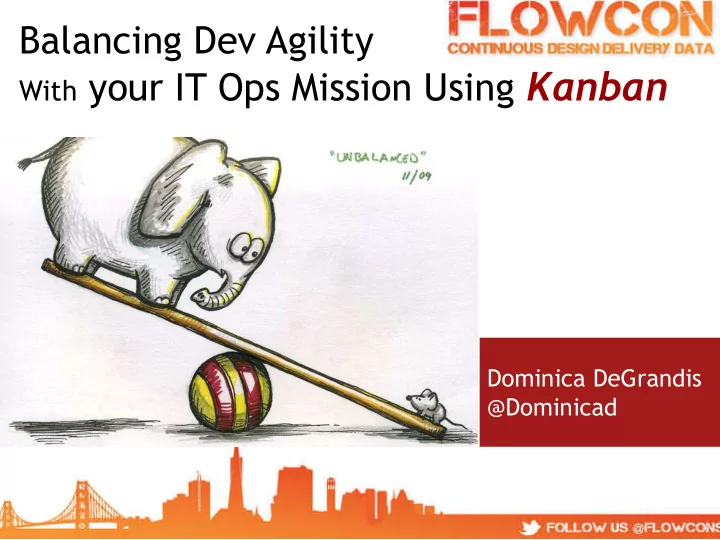

Balancing Dev Agility With your IT Ops Mission Using Kanban ¡ Dominica DeGrandis @Dominicad ¡
Cycle of Frustration TOO MUCH WORK! THINGS TAKE TOO LONG! CONFLICTING THERE’S NO VISIBILITY PRIORITIES
When everything is a priority 1
Context switching is expensive. And irritating! because ... • Multitasking “stop & go” breaks the on-a-roll flow. • Churn and rework create waste.
Kanban practices 1. Make work visible
Bringing visibility to Ops work On Deck Prep doing Prep done Implement Validate Closed Xpedites ¡ ¡ Incident (live issue, security breach) Project A Project Project B Project C Misc. ¡ CODB ¡ because ... • It’s hard to manage invisible work. • Humans absorb info faster visually than any other sense. • Visualization helps us see patterns ¡& ¡ connections that matter.
When the front end gets fixed without addressing the backend.
Kanban practices 1. Make work visible 2. Limit work-in-progress
Bringing limits to amount of work in play On Deck Prep doing Prep done Implement Validate Closed Xpedites ¡ ¡ Incident (live issue, security breach) 3 4 5 96 Project A Project Project B 3 6 8 10 Project C Misc. ¡ CODB ¡ because ... • Knowledge work is perishable. • Churn and rework create waste. • Increased cycle time increases cost.
Time weighs heavily on heroes I ¡CAN’T ¡HOLD ¡ ON ¡MUCH ¡ ¡ LONGER ¡
Kanban practices 1. Make work visible 2. Limit work-in-progress 3. Make process policies explicit
Rules contribute to flow
Infrastructure contributes to congestion
Consider options that allow for improved flow Roundabouts decrease “stop & go” increasing throughput by 20%. What rules would increase Ops throughput? ¡
Ops workflow sample rules Backlog On Deck Prep doing Prep done Implement Validate Closed Xpedites ¡ ¡ Items in backlog remain uncommitted Project and un- prioritized until there is Misc capacity to ¡ absorb them. ¡ Address at Ops Review done Prioritized Auto closed • InfoSec work > 5 days • Arch limited to • CAB available capacity
Calculating Cost of Delay ¡ • Quan&fy ¡cost ¡of ¡delay ¡–Calculate ¡missed ¡revenue ¡ (new ¡revenue ¡or ¡protecDng ¡exisDng ¡revenue) ¡ • Incurred ¡costs ¡(staff, ¡data ¡centers, ¡vendors) ¡or ¡ fines/penalDes ¡(regularity, ¡contractual) ¡SOX ¡ compliance. ¡Sum ¡of ¡cost ¡of ¡delay ¡of ¡other ¡projects ¡ (oSen ¡missed) ¡ ¡ ¡ hTp://focusedobjecDve.com/cost-‑of-‑delay/ ¡ Troy Magennis - http://focusedobjective.com/cost-of-delay/
Kanban practices 1. Make work visible 2. Limit work-in-progress 3. Make process policies explicit 4. Measure flow
Measure workflow Prep done/ On Deck Prep doing Closed Implement Validate Approved Xpedites ¡ ¡ Project Misc. ¡ because ... Historical cycle time provides ability to set customer expectations. • Discovering where and why work gets bottlenecked is useful. • Looking at trends over time reveals improvement (or not). •
How long has work been idle? 10 ¡ 9 ¡ 8 ¡ 7 ¡ 6 ¡ # ¡of ¡&ckets ¡ 5 ¡ 4 ¡ 3 ¡ 2 ¡ 1 ¡ 0 ¡ 10 ¡ 20 ¡ 30 ¡ 40 ¡ 50 ¡ 60 ¡ 70 ¡ 80 ¡ 90 ¡ 120 ¡ 150 ¡ 180 ¡ 210 ¡ 240 ¡ 270 ¡ 300 ¡ More ¡ # ¡days ¡work ¡si5ng ¡in ¡Implementa&on ¡
Rate of incoming vs. outgoing
Measure for objectivity
Kanban practices 1. Make work visible 2. Limit work-in-progress 3. Measure flow 4. Make process policies explicit 5. Develop feedback loops
OpportuniDes ¡to ¡hear ¡and ¡to ¡be ¡heard ¡ Lean Coffeehttp://leancoffee.org/
Operations Review ¡ Reflect on quantitative performance measures
Quantitative performance measures • WIP (work-in-progress) • Cycle time/Lead time • Throughput • Quality • Issues & blocked work Across: ¡ Trend & Variability
Kanban practices 1. Make work visible 2. Limit work-in-progress 3. Measure flow 4. Make process policies explicit 5. Develop feedback loops 6. Evolve Experimentally using models & theory
Experiment with applicable models & theory
Balance Dev Agility with your IT Ops Mission Using Kanban ¡ www.ddegrandis.com Dominica DeGrandis Kanban for Devops & IT Ops @Dominicad dominica@ddegrandis.com ¡ ¡
Recommend
More recommend